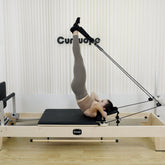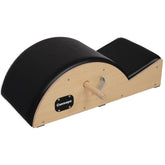What are the differences between Pilates Reformer and mat classes?
Pilates is a popular form of exercise that focuses on developing core strength, improving posture, and enhancing flexibility and balance. There are two main types of Pilates classes: reformer classes and mat classes. While both types of classes share similar principles and movements, there are some key differences between them. In this article, we'll explore the differences between Pilates reformer and mat classes.

Pilates Mat Classes
Pilates mat classes are typically performed on a mat or other flat surface, and focus on developing core strength, improving flexibility, and promoting proper alignment and posture. Mat classes typically use bodyweight exercises and small props such as resistance bands, foam rollers, and small balls to challenge the muscles and improve overall fitness.
The Benefits of Pilates Mat Classes
Flexibility: Pilates mat classes can help improve flexibility by targeting muscles that are often tight or overused, such as the hips, hamstrings, and shoulders.
Core Strength: Pilates mat classes are designed to develop core strength, which is essential for good posture, balance, and overall fitness.
Convenience: Pilates mat classes are convenient and easy to do at home, making them a popular choice for people with busy schedules or who prefer to exercise at home.
Pilates Reformer Classes
Pilates reformer classes are typically performed on a specialized piece of equipment called a Pilates reformer. The reformer is a machine that consists of a carriage that slides back and forth on rails, with springs and other attachments that provide resistance and support for various exercises. Reformer classes typically focus on developing strength, improving flexibility, and promoting proper alignment and posture.
The Benefits of Pilates Reformer Classes
Increased Resistance: The Pilates reformer provides greater resistance than mat exercises, making it a more challenging workout and helping to build strength more quickly.
Variety: The Pilates reformer offers a wide variety of exercises that can be performed in different positions and angles, providing a more dynamic and engaging workout.
Customizable: The resistance on the Pilates reformer can be customized to the individual's fitness level, making it a good choice for both beginners and advanced practitioners.
The Differences Between Pilates Reformer and Mat Classes
Equipment
The most obvious difference between Pilates reformer and mat classes is the equipment used. Pilates reformer classes are conducted using a specialized machine called a Pilates reformer. The reformer consists of a sliding carriage that is attached to springs, ropes, and pulleys. The carriage can be moved back and forth along the frame of the reformer, and the resistance of the springs can be adjusted to provide a customized workout. Pilates mat classes, on the other hand, are conducted on a simple mat, without any additional equipment.
Resistance
Another key difference between Pilates reformer and mat classes is the level of resistance. In reformer classes, the resistance is provided by the springs on the reformer, which can be adjusted to increase or decrease the difficulty of the exercises. In mat classes, the resistance is provided by the weight of the body and any additional props, such as resistance bands or weights. While both types of classes can provide a full-body workout, reformer classes may be more effective for building strength and toning muscles due to the added resistance.
Range of Motion
Pilates reformer classes offer a wider range of motion compared to mat classes. The reformer's carriage can move in multiple directions, allowing for greater range of motion in exercises such as leg presses, lunges, and chest presses. The reformer also provides more support for the body during exercises, allowing for deeper stretches and greater range of motion. In mat classes, exercises are typically performed in a more limited range of motion due to the lack of equipment and support.
Personalization
Pilates reformer classes can be more personalized compared to mat classes. The resistance on the reformer can be adjusted to match the individual's fitness level, allowing for a customized workout that is tailored to their needs and goals. In addition, the reformer provides more options for modifying exercises to accommodate injuries or limitations. Mat classes, while still customizable, may be more limited in their modifications due to the lack of equipment.
Cost
Finally, there is a difference in the cost of Pilates reformer and mat classes. Pilates reformer classes generally cost more than mat classes, due to the expense of the equipment and the need for specialized instruction. Mat classes, on the other hand, require minimal equipment and can be conducted in a larger group setting, making them more affordable for those on a budget.
In conclusion, both Pilates reformer and mat classes offer a range of benefits and can be an effective way to improve fitness, flexibility, and overall health. Choosing between the two types of classes depends on personal preferences, fitness goals, and budget. Some people prefer the convenience and simplicity of mat classes, while others enjoy the challenge and variety of reformer classes. Ultimately, the best choice is the one that fits your needs and goals, and that you enjoy and look forward to doing on a regular basis.





